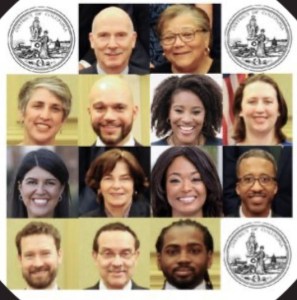
The District of Columbia Council is working on the decennial redistricting required by D.C. law. (Courtesy Photo)
By Katia Pechenkina
Special to the AFRO
The D.C. Council Committee of the Whole Subcommittee on Redistricting held a public hearing on Sept. 29. The redistricting process happens once in a decade after the U.S. Census data is released. The process is designed to determine the boundaries for each one of the District’s eight wards and the Advisory Neighborhood Commissions.
Council members Elissa Silverman (I-At Large), Anita Bonds (D- At Large) and Christina Henderson (I- Ward 8), who make up the subcommittee, are appointed by Council Chairperson Phil Mendelson. The subcommittee will have ninety days to determine the District’s ward boundaries. Wards 6, 7 and 8 currently require rebalancing. Once the new ward boundaries are established in December, the Council will proceed with reapportioning the boundaries of the Advisory Neighborhood Commissions and make decisions by June 2022.
During the live-streamed public hearing, the members of the subcommittee on redistricting introduced a newly released online mapping tool available for the public use and participation in the process. Members of the Subcommittee on Redistricting assured the public of their plans to consider the City’s residents’ input on the redistricting process. Ward maps drawn and submitted by the public will also be taken into consideration.
According to the latest U.S Census data, the District’s population was 689,545 persons in 2020. The Council’s Subcommittee will need to make sure each of the District’s wards will have about 86,193 residents, with a deviation of 5 percent.
“We need to meet the constitutional requirement of one person per one vote,” said Council member Silverman (I), who chairs the subcommittee. She said that by the end of the redistricting process Ward 7 would need to add at least 5,628 residents and Ward 8 would need at least 3,370 residents. Ward 6 is currently overpopulated.
“The fact is Ward 6 must shrink, and Wards 7 and 8 must grow,” said Henderson.
“How do we do this without diminishing the political voice of historically Black and Brown neighborhoods in our City,” a question Henderson asked herself and the members of the subcommittee, as she expressed her interest in ensuring that everyone has fair access to political representation.
The data shows that since the last redistricting process all Wards gained population, but not all Wards added residents equally.
“I think we need to be honest on the role race will play in this process,” said Silverman. She mentioned hearing “very racially coded language” from members of the public who have spoken up about the process. Silverman said that the subcommittee is working with the Office of Racial Equity to address race and diversity issues.
Some of the District’s residents and ANC commissioners participated in the live testimony during the hearing.
ANC6A07 Commissioner Sondra Phillips-Gilbert shared her views on the redistricting process. “We fought hard to remain in Ward 6,” she said. “If we are to be fair and transparent then we should look at sharing the wealth and the economic prosperities in the area of growth and development in Ward 6 to other Wards that it borders,” said Phillips-Gilbert. “If we’re moved to Ward 7, our political vote is diluted.”
Several commissioners expressed their concerns about the technological divide that the District’s residents face even today, in particular, senior residents who do not have access to the internet.
David Stephen, political and legislative director or the Metropolitan Washington Council and resident of Ward 7 recommended that the D.C. Council “ensures that we find effective ways to engage those on the other side of the digital divide.”
“This is the only way that we would be able to make sure that as many voices as possible are heard and will guide us in any specific recommendations that the Council should make,” Stephen added.
“The equal input of these communities (Wards 7 and 8) and their Black and Brown residents must be a priority to ensure a fair representative democracy,” Stephen said. We must implement strategies of engagement to meet people where they are.”
ANC5C03 Commissioner Pierre Hines pointed out that there are challenges that come with the new mapping tool. “There is no substitute for a hard map…There are going to be seniors who cannot use this mapping tool. We saw this with COVID,” Hines said. “And so I hope we don’t make those same mistakes of leaving out an entire segment of the population into this very, very important process.”
Parking, and specifically whether the ward redistricting process will impact the residential permit parking privileges was one of the issues discussed during the public hearing.
Council member Henderson announced that she would be introducing the legislation to separate the residential parking permits from the ward boundaries, and was hoping to have “much more focused conversation” if the parking issue was not a part of the redistricting process. Ward 6 Council member Charles Allen (D) expressed his support of Henderson’s parking proposal.
Change is coming to the boundaries of the District’s wards. “There is no way around it…. Ward 6 is going to look different next year. I don’t like it, I don’t want it, but that’s the reality,” said Allen.
“I’m oddly excited about what is to come. It will certainly be a challenge, but the result gives us an opportunity to shape the District for the next ten years,” Henderson said. “I know that change is difficult, and yet the law states that every ten years, change, we must.”
The Subcommittee will hold eight public hearings on ward redistricting in October and the final hearing will take place in early November. The votes on the bill will come in December. The whole timeline is outlined on Council member Silverman’s website.
Help us Continue to tell OUR Story and join the AFRO family as a member – subscribers are now members! Join here!
The post Council meets for decennial redistricting appeared first on AFRO American Newspapers .










